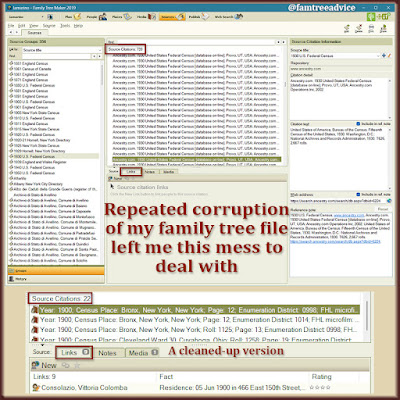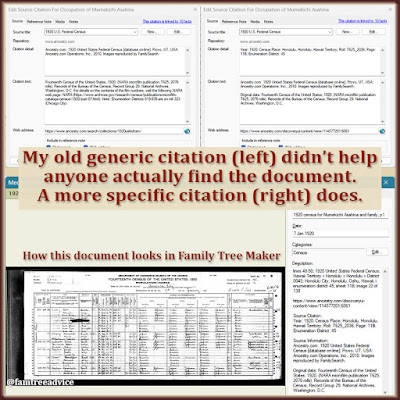Last week I had to swear off synchronizing my Family Tree Maker file with my tree on Ancestry. (See "A Major Family Tree Change to Fix an Ongoing Problem.") Too many failed syncs made it impossible to go on. In fact, those failed syncs did more damage to my desktop tree than I knew. I'm determined to see this as an opportunity to improve my family tree.
 |
| Failed syncs of my Family Tree Maker file left me with tons of splintered and unlinked source citations. |
During my corporate life, I always hated when a boss would call a pain-in-the-butt project an "opportunity." An opportunity to improve our website. An opportunity to improve our support for the sales team. It wasn't an opportunity for workers like me who had countless hours of grunt work ahead of us. Don't try to sugar-coat that burden.
Yet here I am calling this problem an opportunity to improve the source citations in my family tree.
There were 2 things I now know happened to my desktop tree with each failed sync:
- My tree no longer recognized some addresses. This was plain to see and easy enough to fix. I viewed each bad address in the Places tab of Family Tree Maker and made a few clicks. If you use FTM, see the company's instructions for standardizing locations.
- My tree split my shared source citations into a bunch of identical citations. That's because an Ancestry tree sees each citation differently than FTM. Many citations weren't linked to anyone at all. These may be leftovers from people I deleted without first deleting their citations. Thousands of duplicate citations were increasing my tree's file size dramatically.
I've had a project on my radar to update citations for documents found on the Italian Antenati portal. The links in my old citations don't work anymore because of a huge change to the Antenati website. Spelling out the town, year, and document number would make each record findable—even if that website changes the links again. But it's a huge task.
Develop a Format and Stick to It
When I saw the mess my U.S., Canada, and U.K. source citations were in, I knew what I had to do. It was time to improve my oldest citations and make them match my current style.
For example, I'm looking at the 1920 U.S. Federal Census document image for my husband's ancestor. These days I like to add a ton of detail to the document image's description. But this early find says only:
https://www.ancestry.com/interactive/6061/4442141_01017/114577201
That's pretty helpful, but my newer format is better. The citation should say this:
https://www.ancestry.com/discoveryui-content/view/114577201:6061
Source Citation: Year: 1920; Census Place: Honolulu, Honolulu, Hawaii Territory; Roll: T625_2036; Page: 11B; Enumeration District: 45
Source Information: Ancestry.com. 1920 United States Federal Census [database on-line]. Provo, UT, USA: Ancestry.com Operations, Inc., 2010. Images reproduced by FamilySearch.
Original data: Fourteenth Census of the United States, 1920. (NARA microfilm publication T625, 2076 rolls). Records of the Bureau of the Census, Record Group 29. National Archives, Washington, D.C.
To be clear, I'm putting that extra long citation into the properties of a document image. When I drag the image into FTM, all that info comes along for the ride. Then I use everything from the URL down to populate the source citation for this document's facts. Let me dissect that format so you can follow my logic.
- lines 48-50 — This tells me and anyone who sees my copy of this document on Ancestry where to look on the page. This goes for ship manifests, too.
- 1920 United States Federal Census — This is the name of the record collection that has this document.
- Hawaii Territory > Honolulu > Honolulu > District 0045 — When you look at the document on Ancestry, this is the detail shown at the top of the screen.
- Honolulu City, Honolulu, Oahu, Hawaii, enumeration district 45, sheet 11B — These details can help locate this document on or off Ancestry.
- image 22 of 138 — This tells you exactly which image to go to in the collection on Ancestry.
- https://www.ancestry.com/discoveryui-content/view/114577201:6061 — The URL points to this record (not the document image) on Ancestry. This URL also contains the Source Citation and Source Information I add beneath the URL. I used to link to the image on Ancestry.com. But it's more useful to link to the record page.
This style includes enough detail so anyone can find the image—even without a link or an Ancestry account. And I attach the image to the Media tab of the citation itself. That's something I didn't know was possible until a few years ago.
Once I finish a citation, I copy and paste it to each family member in the census. And I can delete the duplicate copies each failed sync generated.
How to Check All Your Source Citations
I started this process by looking at the Sources tab in Family Tree Maker. There's a long list of all my sources on the left, in alpha-numeric order. Each one contains lots and lots of citations I can improve and share with each family member. In the end I'll have a neat, perfect list of citations with no duplicates.
 |
| As long as there's a mess to clean up, why not make the source citations in my family tree live up to my standards? |
Each time I delete a ton of duplicate or unlinked citations, my tree's file size gets smaller. Amazingly, my FTM file went from 4 gigabytes on my failing laptop to 360 megabytes on my new computer. I'm still in shock.
I look forward to uploading my improved, streamlined GEDCOM file to Geneanet.org. I'll overwrite the version that's there, rather than synchronize it. I want anyone who sees that tree to find usable links to every bit of evidence I have for a person.
Once I finish my long list of U.S., Canada, and U.K. citations, I'll figure out how to tackle those obsolete Antenati citations.
Even if you haven't suffered damage to your family tree, revisiting your earliest citations is worthwhile. Have a look at them and see how many you're happy with. Bringing them all up to your standard will fortify your family tree.
Thank you! I need to do this, and you showed me how.
ReplyDeleteDo try to make it a firm habit. From now on, when you add anything to your tree, get the source in there right away!
DeleteWe're on the same path - since moving my tree to Family Historian last year, I've been improving my sources. Is it slower than adding with Ancestry? Yes.... Are they better sources, though? Yes... A labour of love indeed, but one I know will make my database much stronger. Good luck with your project :)
ReplyDeleteI've worked on my citations before, but I never knew they were being torn apart behind the scenes. I'm happy to get them right and know they'll stay that way.
DeleteThat is exactly one of the reasons I type the sources along with the document transcription into my notes. You have shown me how to get rid of all the duplicates in the source fields, however. Maybe I can get my tree smaller gigabite wise. I have almost 51,000 individuals in it.
DeleteI started updating and improving my 30 years of source citations about 6 months ago, and I think it will take me most of 2023 to finish. It's a worthy and necessary task that'll I'll be proud of when I'm done.
ReplyDeleteThat's definitely something to be proud of!
DeleteI'm finally moving over from a paper-based system, and putting all my records on Mac Family Tree. I'm taking the opportunity to review and fine-tune all my citations. There's some great ideas in your post, which has given me something to think about.
ReplyDeleteI can't even imagine how much paper you must have. I very rarely print anything...or even write anything. The software can guide you through the process and help you keep consistency in your facts and citations.
DeleteThank you for this. I wouldn't have thought to do this without your post.
ReplyDeleteAs I go through my census citations, I'm amazed at how many I did before settling on my current format. But I'm so happy to see all the duplicates disappear.
DeleteI like your blog, DiAnn. Practical, careful, and not too full of extraneous personal guff like some of the others.
ReplyDeleteI especially like this post about sources. Always a big thing for me as a former academic historian. I tend to create citations as I do back then. Say what the source is and where, in the source, to find the relevant info.
I don't, though, say where I found the source itself. I do give the repository (eg Hampshire Record Office or whatever) but not where I found it online. Perhaps it's a UK census (which many of mine are). These are available on several sites apart from Ancestry. The image quality varies enormously - from near invisible on one site, to completely legible on another. Saying which site I found it on doesn't help someone who doesn't have a subscription to that site. Moreover links can get broken and then it's useless anyway. So I don't bother. After all, if I mention the info is on page 102 of some book or other, I don't say which local library I got it from. The details provided should enable people to find it anywhere.
I might be getting a bit pompous here, of course. It smacks of handholding which I don't encourage. I think the major companies do a lot to encourage poor quality work. 'Click here to add 975 people to your tree' says one. 'Add this hint to your tree' says another. I try not to emulate that. If I simply give the reference RG10/1234 f 34 p 19 (and perhaps the schedule number) anybody should be able to find that document online or on a microfilm. It's not a real reference BTW.
But, overall, your commitment to raising standards is admirable and your tips are often valuable. I'm using some of them myself.
Thanks.
Mick
Thanks for reading and for your comments, Mick. I feel as if I'm providing the best of both worlds with my citations (and the Ancestry links are as helpful to me as anyone else). I've been working on immigration records all day, so a typical citation will include:
Delete-the line #(s) to look at
-the collection name (usually on Ancestry), such as "New York, U.S., Arriving Passenger and Crew Lists (including Castle Garden and Ellis Island), 1820-1957"
-the path to get to the image, such as "Date > 1920 > Jul > 03 > Regina D Italia"...I like this because it tells the ship name and date of arrival
-Source Citation, such as: "Year: 1920; Arrival: New York, New York, USA; Microfilm Serial: T715, 1897-1957; Line: 6; Page Number: 250"...which is good for someone accessing the original materials
-Source Information, such as "Ancestry.com. New York, U.S., Arriving Passenger and Crew Lists (including Castle Garden and Ellis Island), 1820-1957 [database on-line]. Lehi, UT, USA: Ancestry.com Operations, Inc., 2010." … "Original data: Passenger Lists of Vessels Arriving at New York, New York, 1820-1897. Microfilm Publication M237, 675 rolls."
-and finally the URL to get to the record, such as this awful URL: https://search.ancestry.com/cgi-bin/sse.dll?_phsrc=phM728&_phstart=successSource&usePUBJs=true&indiv=1&dbid=7488&gsfn=Antonio&gsln=Paolucci
My earliest saved ship manifests had bad URLs because of changes to how Ancestry is separating groups of images, but the other info would still be valid. It's making me happy to update them all and be consistent. I have a lot more to do.
Well that's fair enough, DiAnn. And it's usually better to have more information than not enough. Anyway, I just looked one of my passenger lists and I left out the line number. I think there are a few like that so that's today taken care of.
DeleteThanks again. Great stuff.